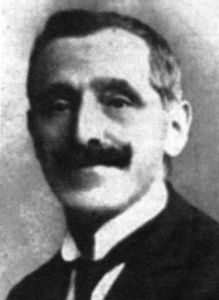Lawyer, banker and alpinist
He was born in Sanremo on 3rd December 1877 to John the Baptist and Caterina Bigio. He was descended from an ancient lineage of the extreme western Liguria of which we have  news in the « History of the Maritime Alps » by Gioffredo (the historian of Nice) on p. 1041, and in the « Marquisate of Dolceacqua » by Girolamo Rossi. The mother also belonged to a well-known local entrepreneurial family, daughter of Giacomo Antonio Bigio, an entrepreneur. of the oil industry.
news in the « History of the Maritime Alps » by Gioffredo (the historian of Nice) on p. 1041, and in the « Marquisate of Dolceacqua » by Girolamo Rossi. The mother also belonged to a well-known local entrepreneurial family, daughter of Giacomo Antonio Bigio, an entrepreneur. of the oil industry.
His father Giovanni Battista had been co-founder, in 1867, of the Asquasciati Fréres English Bank, together with his brothers Carlo Felice and Bartolomeo (the meritorious mayor of Sanremo for fifteen years), launching the definitive economic and social rise of what was one of the main families of Sanremo and the far west of Liguria between the end of the 19th century and the first post-war period.
Bartolomeo first studied at the Regio Collegio Carlo Alberto in Moncalieri, and then attended the University of Parma, where he graduated in law. After graduating, he never practiced law, working in the family bank, an occupation that allowed him, among other things, to indulge his passion for travel, bringing him to know France, England, Austria and Germany in depth. At the age of thirty he married Federica Romamengo, with whom he had two children: Carlo and Adele.
During the First World War, he was special secretary of Donato Antonio Tommasi (1867-1949) at the Supreme Court of War and Navy in Rome and for his services he was awarded the Cross of Knight of the Italian Crown.
Even before the war Asquasciati had already undertaken the activity of mountaineer and explorer of the Sanremo hinterland and the Maritime Alps. Like many wealthy contemporaries, he lived with pioneering intensity a hobby whose characteristics were interwoven between scientific, sporting, purely exploratory interests and simple private pleasure. His activity not only produced the ascent of many peaks still untouched, but also repeated ascents, often with important variations of ascent or descent. In addition, Asquasciati explored the whole of the Imperia hinterland, identifying and divulging many hiking trails, as well as developing variations to already known trails. His passion for exploration was not limited in him to the athletic gesture itself; always accompanied by his camera, which he used personally with a certain skill, he was a very prolific divulger: articles, monographs, descriptions of ascents or hiking trails, often published by the Italian Alpine Club, to which he was a member as well as the French one and several similar associations in France and Switzerland.
Perhaps the most consulted was the guide "Contrafforti e Alpi Liguri", published in 1924 by the C.A.I., section "Alpi Marittime" of Imperia and recommended by the Ministry of War to the Officers for the accuracy of images and descriptions. Of considerable value, also aesthetically, are the albums and the popular "photographic pictures" that Asquasciati produced with the collaboration of his friend Silvio Amoretti, a skilful calligrapher and draftsman who supported him in the work of directing the local section of the C.A.I. The collaboration with the Italian Alpine Club pushed him, in fact, to be for many years vice-president of the Imperia section and to be one of the supporters of the creation of the subsection of Sanremo, which he directed since 1925.
From his role within the Club he personally spent himself for the realization of the "Imperia-Sanremo" Refuge at Lago Verde del Basto (in the upper Valmasca) which, inaugurated in July 1928, was then named after Baron Guglielmo Kleudgen, a colleague and companion of Asquasciati, prematurely disappeared in a mountain accident.
Also to the Maritime Alps section of the C.A.I., he donated a trophy to be raffled in the annual ski mountaineering competition named after Bartolomeo Asquasciati, which saw its first edition in February 1929. Also this competition was subsequently named after the late G. Kleudgen, and under this name it is still held today.
He was also a member of the Italian Touring Club, which availed itself of his collaboration and advice for the revision and updating of all the maps of the Ligurian Riviera and the Alpine Arc.
A tribute to the pioneering importance of mountaineering enterprises in 1929, the Italian Alpine Club wanted to name a peak of the Massif of Monte Clapier, which he climbed for the first time from the east ridge: the altitude 3034 has since then been named "Punta Asquasciati".
Caught sick, in just four days he died on 2 April 1933 in Sanremo, at the age of 55.
(source Marco Mauro)




